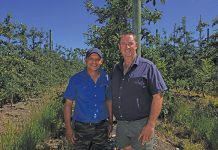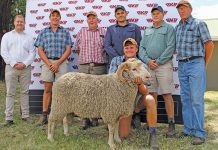The National Soya Bean Cultivar Trials for 2006/07 conducted by the ARC-Grain Crops Institute identified the best-adapted cultivars for different growing areas in SA. Some 30 cultivars were included and data of 27 localities were acceptable for statistical analyses. The yield reliability values of the cultivars for the three production areas (warm, moderate and cool) are presented in Tables 4 to 6, 7 to 9 and 10 to 12 respectively. The information in Table 2 determines if the area to be planted corresponds with the warm, moderate or cool localities. Use the yield reliability tables (warm, moderate or cool) to select cultivars for the yield potential of the specific farm.
Characteristics for cultivar choice The length of the growing season is the most important characteristic to consider for cultivar choice. Soya beans are sensitive to day length (photoperiod), and certain cultivars will ripen later and demonstrate a longer growing season the further south they are planted in Southern Africa. Planting dates will therefore also affect the length of the growing season and a given cultivar will flower earlier if it is planted at a later date. Prevailing temperatures also affect soya beans.
Table 1 illustrates the variances for length of growing season between cultivars and the different production areas. Experienced soya bean farmers can use the photoperiod sensitivity of soya beans, along with the genetic variances for relative length of the growing season, for hay production (a soya bean cultivar with a long growing season can be used), for scheduling of harvest (planting cultivars with differing ripening dates) and for drought avoidance or emergency planting (using cultivars with short growing seasons). However, this characteristic could also prove hazardous when the wrong cultivar choice is made and the yield is not realised because it firstly does not ripen (a too long grower has been planted for the area), secondly is ready for harvesting while rain and high temperatures hamper harvesting and impair quality (a too short grower has been planted), and lastly is unable to be harvested because of a too low pod height (possibly a good cultivar planted too far north). Cultivar choice using length of the growing season I t’s important for soya bean producers to determine if the area that will be used for production is similar to the grouping of localities indicated by the warm, moderate and cool production areas (see Table 2).
Generally, cultivars with a longer growing season will perform better in the warmer growing areas, those with a medium growing season in the moderate growing areas and cultivars with a shorter growing season perform better in the cooler production areas. But because there are exceptions it’s recommended to also use yield performance and adaptation with the length of the growing season in cultivar selection for a specific area (see Tables 4 to 12). Planting date influences adaptation and therefore cultivar choice. The optimum planting date is usually in November, but in warmer areas soya beans can be planted until the first week of January. When planting later, narrow rows, higher plant populations and cultivars with shorter growing seasons are recommended.
It’s suggested to plant in October, especially in the higher-lying areas, where soil and air temperatures reach acceptable levels early in the growing season. Planting at an earlier or later planting date will affect cultivar choice. Pod and plant height impact on the ability to harvest the crop, and are characteristics that should be considered with cultivar choice. Cultivars with a shorter growing season tend to have lower plant and pod heights, compared with longer growing season cultivars under similar conditions. Both characteristics are influenced by production practices. More narrow inter- and intra-row spacing will increase pod height significantly (see Table 3).
Standability is affected by the number of overcast days. Plant height tends to increase in these conditions and could result in a higher lodging percentage. Growth habit distinguishes between determinate and indeterminate genotypes. Cultivars with a determinate growth habit are preferably planted under irrigation, while indeterminate cultivars (that do not cease vertical growth during flowering) are preferred under dryland and cool weather conditions (see Table 3). Genetic resistance against disease and pests is relevant where the probability of such a risk increases. The cultivar with known resistance against soya bean mosaic virus is Ibis, and against paranocheta SCS 1. Root knot nematode sensitivity is reported in Table 3.
Row width also affects cultivar selection. Those producing more side branches and leaves are better adapted to wider rows, while cultivars with fewer side branches and leaves are better adapted to narrow rows. Resistance to seed shattering plays a vital role during unfavourable harvesting conditions. Information from the trials indicates that cultivars with a short growing season tend to shatter more than those with a longer growing season. Sensitivity to herbicides can influence cultivar choice. No soya bean is resistant to atrazine-type herbicides and the full waiting period will have to be maintained before soya can be planted. Because cultivars such as Dumela, Ibis, Komatie and Edgar are sensitive to metribuzin, it should never be used on them.
Seed size, hilum colour, protein quantities and GMO status are characteristics that can negotiate a premium on the market. Seed size is genetically regulated, but is greatly influenced by the environment. Favourable conditions during the seed filling period will positively influence seed size. The protein content of the seed is also genetically regulated and can be negatively affected by the environment and poor crop management. Protein content below 36% is unsatisfactory and above 40%, on a moisture-free basis, is excellent. Seed yield indicates the genetic adaptation and the suitability of a cultivar to be planted in a specific area. Visit www.arc.agric.co.za. |fw








